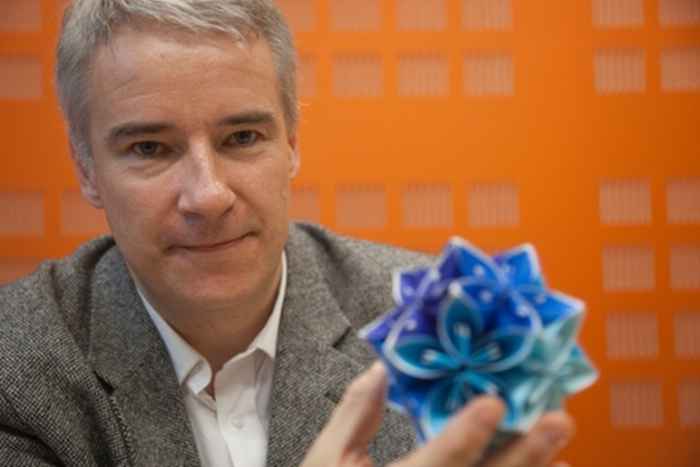Focus on Research: mathematician Eric Opdam

'A girlfriend once said to me, "So, you spend the whole day thinking up exercises, and then you solve them yourself?" But that's not what mathematicians do with their lives. We are studying a reality. A mathematical reality, populated by numbers, spaces and symmetries.'
These days Eric Opdam is married to a Japanese mathematician with a PhD, with whom he can swap ideas about his field to his heart's content. Not that mathematics is ever a topic of discussion at home, he says. 'The children make sure of that.' Similarly, he discusses little of what he's working on with his friends, although they include engineers, historians and linguists. ‘It's simply that people outside the field aren't familiar with many concepts that are very basic for us as mathematicians. The gap is too wide to bridge.'
Opdam concludes that it is very difficult for outsiders to form an impression of pure mathematical research. He has been Professor of Algebra and Geometry at the Korteweg-de Vries Institute for Mathematics since 1999. He is dismayed by this inaccessibility, because personally he's very enthusiastic about his field. ‘We don't just make up things: everything in mathematics is inherently consistent. Facts discovered thousands of years ago are just as true today. You could say that a thread runs right from the mathematics of the ancient Greeks to my field of work, a golden thread.'
Regular polyhedrons
Symmetry is an important theme in Opdam's work; it's something the ancient Greeks were already considering. ‘For example, Plato described the regular polyhedrons. These are spatial figures assembled from identical regular faces. At every vertex the faces meet in the same way. There are precisely five of them and they are perfectly symmetrical.' Opdam types in something at his keyboard to illustrate this remark. Then he pulls round the screen showing the Wikipedia description of Platonic solids. He points.

‘The simplest is a tetrahedron, assembled from four triangles with equal sides. Then there's the cube, made of six squares, and the octahedron. A really interesting one is the dodecahedron. You can rotate that in sixty ways and it will always occupy its original space. The Greeks assigned a mystical meaning to this figure; they associated it with the element Aether.'
Although the mathematical world holds no mysticism for Opdam, he says that the Platonic reality nevertheless continues to intrigue him. An example of symmetry can be seen in the solutions of a quadratic equation. If you solve such an equation using the well-known Quadratic Formula, there's a simple symmetry, because you extract a root that can be either positive or negative. You also find symmetries in the solutions of equations of higher degree, symmetries that show ever more complex patterns.
History of research on symmetry
For a long time after the period of classical antiquity, there were only a limited number of developments in the field of symmetry, Opdam explains. This changed in the nineteenth century when the Frenchman Évariste Galois had a brainwave about fifth-degree equations. No formula exists for solving these; Galois realised that an explanation of this fact is hidden in the properties of the symmetries of the regular dodecahedron.
Later in the nineteenth century other scientists further developed these insights. The Norwegian Sophus Lie put forward continuous symmetry groups, now known as Lie groups. Examples of these are a circle or a sphere - but one that exists in four dimensions. ‘You can study these by making realisations of them in spaces with an infinite number of dimensions,' explains Opdam. ‘And what is really neat is that these realisations played a vital role in quantum theory in the twentieth century. Nobody had predicted that. And even now they are continuing to be a very important tool in that field.' An example of this is the fundamental role of Lie groups in the description of elementary particles in physics.
Scientific challenge
Within mathematics, too, the stream of new developments was unabated, continues Opdam. ‘In 1967 the mathematician Robert Langlands (IAS, Princeton) conjectured that Lie groups and the small symmetry groups - those involved in the solutions of equations of higher degree - were two sides of the same coin.' Opdam terms this a brilliant insight. ‘He captured an aspect of mathematical reality'. Proof of Langlands' conjecture has still to be found. ‘It is a magnificent correspondence, ' says Opdam. ‘If you assume that Langlands' conjecture is true and you calculate the consequences for both sides, the results are astounding. We don't know why, but the predictions seem correct at every level. A proof of this Langlands Correspondence that is ultimately what I hope to find.'
He realizes that this is not going to happen in the very near future. ‘I've now got a concept that provides answers in certain situations. I'm happy with this, but these are only preliminary results. The real application is still well-hidden from me. But I hope, one day, to fit together all the sub-results gained along the way to solve the big puzzle.'
Teamwork
To do this, Opdam doesn't sit alone all day thinking up and solving exercises, as he himself said. ‘Much of my work is teamwork. I do a lot of work with students, and my research group is participating with other research groups in Utrecht and Nijmegen in The fellowship of Geometry and Quantum Theory, a research cluster funded by NWO that also includes physicists. We meet up regularly to discuss recent developments. This exchange is very valuable to our research. It also creates a broad-based and inspiring environment for the PhD students and postdocs in the department. Now that's how you learn things!'
Published by Faculty of Science
2 August 2012